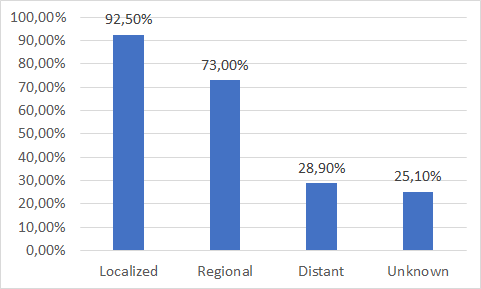Ovarian Cancer
Overview
Ovarian cancer is caused by an abnormal growth of cells in the ovaries ―the reproductive glands found only in females (women) that produce eggs (ova) for reproduction―, and is responsible for more deaths than any other gynecologic cancer being among women the eighth most common cancer and the fifth leading cause of death, being most common in Caucasians that in African American.
Types of Ovarian Cancer
There are 3 different types of Ovarian Cancer, which are classified according to the type of cell from which they originate, such as:
- Epithelial Tumors: tumors that occur in the epithelium, the tissue lining the outside of the ovary. Approximately 90% of Ovarian Cancers are of this type. The risk of epithelial Ovarian Cancer increases with age and affects mainly women over 60 years, but can occur at any age. There are various types of Epithelial cancers of the ovary:
- Serous
- Endometrioid
- Clear cell
- Mucinous
- Undifferentiated or unclassifiable
- Germ Cell Tumors: tumors that originate from egg-producing cells present in the ovary. This type of Ovarian Cancer can occur in women of any age, but affects mostly adolescents and young adults under 30 years. About 5% of all Ovarian Cancers are Germ Cell Tumors. There are various types of Germ Cell Tumors of the ovary:
- Teratoma
- Dysgerminoma
- Endodermal Sinus Tumor (EST)
- Sex Cords-Stromal Tumors: tumors that develop in the connective tissue that holds the ovary together and produce the female hormones, estrogen and progesterone. Sex Cords-Stromal Tumors are relatively rare, so that account for about 1% of all Ovarian Cancers. There are various types of Sex Cords-Stromal Tumors of the ovary:
- Pure Stromal Tumors
- Pure Sex Cord Tumors
- Mixed Sex Cord-Stromal Tumors
Risk Factors
A number of factors may increase your risk of Ovarian Cancer. Some risk factors can be controlled, for instance, by quitting smoking. And other factors can’t be controlled, such as your family history.
Risk factors for Ovarian Cancer include:
- Age
- Obesity
- Reproductive history
- Birth control
- Gynecologic surgery
- Fertility drugs
- Androgens
- Estrogen therapy and hormone therapy
- Family history of Ovarian Cancer, breast cancer, or colorectal cancer
- Family cancer syndromes
- Hereditary breast and Ovarian Cancer syndrome
- PTEN tumor hamartoma syndrome
- Hereditary nonpolyposis colon cancer
- Peutz-Jeghers syndrome
- MUTYH-associated polyposis
- Personal history of breast cancer
Symptoms and Signs
Ovarian Cancer may cause several signs and symptoms. Women are more likely to have symptoms if the disease has spread beyond the ovaries, but even early stage Ovarian Cancer can cause them. The most common symptoms include:
- Bloating
- Pelvic or abdominal pain
- Trouble eating or feeling full quickly
- Urinary symptoms such as urgency (always feeling like you have to go) or frequency (having to go often)
- Fatigue
- Upset stomach
- Back pain
- Pain during sex
- Constipation
- Menstrual changes
- Abdominal swelling with weight loss
Prognosis
Survival in Ovarian Cancer is also strongly associated with tumor stage: when the cancer is detected early ―Stages I or II―, the survival rate at 5 years is 95% and 65%, respectively, but the lack specific symptoms makes it also known as the “silent murderer” because 75% of patients arrive at an advanced stage ―III or IV Stages―, without having had previous symptoms, where survival rates are low.

Besides ―in a similar way to what happens in lung-cancer― it is necessary to remove those suspicious ovarian masses, which in most cases are not cancerous (only in the United States each year are removed between 200,000 and 300,000 of these suspicious ovarian masses).
Ovarian Cancer Diagnosis
PLEASE NOTE: EARLY DIAGNOSIS IN CANCER IS VERY IMPORTANT BECAUSE CANCER THAT’S DIAGNOSED AT AN EARLY STAGE, BEFORE IT’S HAD THE CHANCE TO GET TOO BIG OR SPREAD IS MORE LIKELY TO BE TREATED SUCCESSFULLY. IF THE CANCER HAS SPREAD, TREATMENT BECOMES MORE DIFFICULT, AND GENERALLY A PERSON’S CHANCES OF SURVIVING ARE MUCH LOWER.
As shown in the chart below, in Ovarian Cancer, like many other cancers, mortality is substantially higher in patients whose disease is diagnosed in late stage or has metastasized to other organs.

State of the Art
Currently, there is no effective method of early detection of Ovarian Cancer. It is usually diagnosed in advanced stages and only half of women survive more than five years after diagnosis.
Multiple studies have shown that the prognosis and survival depend largely on the amount of tumor remaining at the time of the initial surgery. Patients without residual tumor or nodules smaller than one centimeter in diameter have the greatest chance of cure and long-term survival.
Most women with Ovarian Cancer have symptoms. However, these symptoms are often vague and can be attributed to less serious conditions such as indigestion, weight gain or the consequences of aging, which makes it really difficult diagnosis. In this sense, when pathology is suspected, a physical examination is performed and then is followed ―if palpation enlarged ovary or fluid in the abdomen (ascites)―, by different diagnostic procedures ―such as ultrasound image, computed tomography (CT), positron emission tomography (PET) or magnetic resonance (MR)―.
Doctors have tried different methods for early diagnosis, including the use of CA 125 Tumor Marker, but the results are not satisfactory, since this marker has a low Sensitivity in the early stages while offering a high proportion of false positives (FP) in premenopausal women.
For some years, the valuation levels of HE4 ―a “novel” Tumor Marker―, offers greater Sensitivity for these early stages, and greater Specificity, so that through a combination of the values of CA125, HE4 and menopausal status of the patients, It was designed the ROMA (Risk of Ovarian Malignancy Algorithm) ―an algorithm with 3 variables and low complexity to help physicians in the diagnosis of Ovarian Cancer―.
Another different approach sought to improve early diagnosis by combining the CA125 and characteristics of the ovarian mass obtained by ultrasound, which led to the RMI (Risk of Malignancy Index for Ovarian Cancer) program.
Both algorithms are useful to help in the diagnosis of abdominal masses, and in the monitoring of treatment, but both can be clearly improved because ROMA does not consider ultrasound or age of the patient and the RMI does not use the best tumor marker to date for the diagnosis of Ovarian Cancer (HE4), well as other variables that we have found are related to this disease in our own MBDAA Test for Ovarian Cancer.
Diagnosis Revolution
Here is where our solution can help by being an innovative, non-invasive, accurate, and cost-effective diagnosis solution, based in a simple blood test that can detect Ovarian Cancer with 93.8% of Sensibility and 94.4% of Specificity, while reduces ―in a very significantly way―, the number of false positives (FP) and false negatives (FN) typical of other diagnosis procedures.
If do you want to read more about OncoOVARIAN Dx, our Multiple Biomarkers Disease Activity Algorithms (MBDAAs) for an innovative, non-invasive, accurate, and cost-effective Ovarian Cancer diagnostics, please click on next button:

